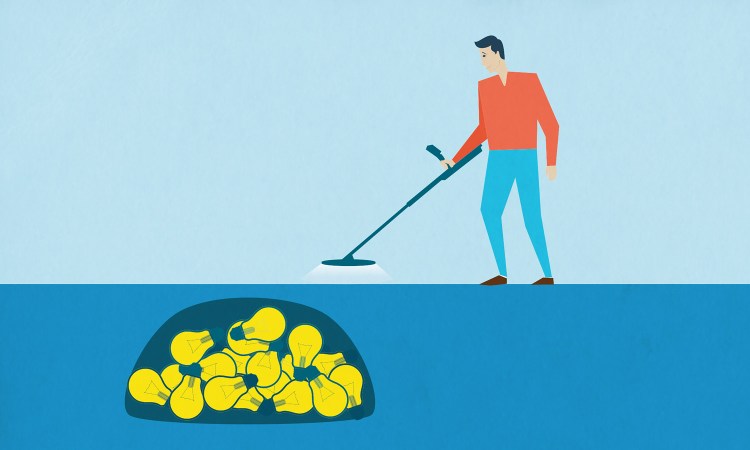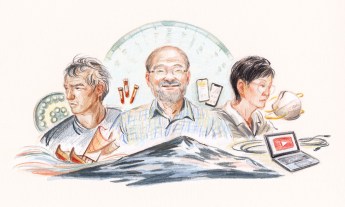
What drives invention? Sometimes, it’s back pain. Here’s how to prime your own creativity to make something new.
When Pagan Kennedy was writing her Innovation column for The New York Time Magazine, she and her editor would come up with intriguing discoveries or objects, and then she would look backward to figure out how they were created — and by whom. “I started noticing that a lot of the ideas didn’t come from professional inventors or engineering classes,” Kennedy says. “They came from people who were in a position to see a problem that needed fixing in a very personal way.” Kennedy collects some of those remarkable stories in her book Inventology: How We Dream Up Things That Change the World. We asked Kennedy to cull some of the fundamental traits and conditions that lead to brilliant creativity.
Your aching back, or that pinch in your neck, could push you to greatness. Jake Stap was having a heck of a time getting the kids to pick up tennis balls when he ran camps in Wisconsin in the 1960s. The onus fell on him, causing severe backaches. He was feeling desperate. He needed to solve the problem. “A key to Stap’s invention is that the frustration had to be of long duration,” Kennedy says. “If it’s short, then a half solution would do fine. But the dread of the next summer forced him to think past half-solutions.” Stap put a tennis ball on the passenger seat of his car and spent the winter looking at it, playing with it, and considering solutions to the problem, including a retractable arm, until he came up with the now-ubiquitous metal-basket tennis ball hopper. Similarly, Bernard Sadow, a luggage company executive, was toiling through an airport in the early ‘70s lugging two suitcases. He noticed airport workers pushing a machine on a dolly, giving him the idea that he could ease his load by putting wheels on his suitcases. But his solution — a sort of leash that pulled a bag — was still clunky, especially if you had to go around a sharp corner. About a decade later, pilot Robert Plath, who also spent much time huffing through airports, came up with a better solution — wheels on one edge of a bag, with a rigid handle that could be extended.
Keep an open mind, and you just might stumble on to something. In her book, Kennedy cites a study that found that more than 50% of patent owners credited a serendipitous event for their invention. In other words, inventors were not aiming to create what they ended up creating. But because they were open to what was around them, they made great discoveries. In the early ‘80s, NASA engineer Lonnie Johnson was tinkering to see if a heat pump could use water instead of freon when he tested a nozzle and noticed that it projected water in a “cartoonish” way, which reminded him of a child’s water gun. The Super Soaker was born.
Love conquers all. Kennedy noticed that passion was a key component in the discoveries made by Stap, Johnson and other inventors. “They fall in love with it. And the love is what keeps them going,” she says. Often, a discovery becomes a “favorite party trick,” which the inventor shows off to friends. They think about it day and night. “It doesn’t feel like work. They see the possibility and they are motivated,” which drives them all the way through the arduous process of development and, eventually, certifying a discovery.
No inventor is an island. Kennedy found that an essential ingredient to many inventions was that they were forged through communication with a community. Serial inventor Dick Belanger kept a book he called, “Dick’s book of dumb ideas,” which included a fogless bathroom mirror, a tennis ball inflater and a hot dog-shaped hamburger. He bounced the ideas off friends and family. Eventually, they helped guide him toward pursuing his idea for a no-spill sippy cup that used an air vacuum to trap water inside. Fellow parents helped fine-tune his cleverly designed cup. “For Belanger, feedback was most important in helping him avoid ideas that were likely to fail or fizzle,” Kennedy says.
It’s easier than ever to get your new product made. We are living in an era when the barriers to innovation are disappearing. “You have more inventive tools on your phone than what the top engineers at Bell Labs had in the 1960s,” Kennedy says. China’s manufacturing city of Shenzhen has become an accessible hub where inventors can find factories primed to produce new electronics and objects — like those myriad variations on the selfie stick. 3D printers make prototypes affordable and accessible. And, like never before, manufacturers and pop-up factories around the world are motivated to work with individuals and small companies that can get financing through crowdfunding and venture capital. “My job used to be so hard,” independent inventor Chris Hawker told Kennedy. In the 1990s, when Hawker was working on an algae scraper for fish tanks, he spent days on research, writing down phone numbers and then calling factories. Now, he said, “I can just get on Alibaba,” and look up articles on Wikipedia and talk to people in minutes to research and source component parts. “Invention is being reinvented,” Kennedy says.
Illustration by iStock.











